Kids on the Slope is slice-of-life anime, and it’s also a rare case of director Shinichiro Watanabe (Cowboy Bebop; Samurai Champloo) adapting an existing work: a manga called Sakamichi no Apollon by Yuki Kodama. Wikipedia summarizes the plot like this:
The beginning of summer, 1966.
Because of his father’s job situation, freshman high school student Kaoru Nishimi moves by himself from Yokosuka to Kyushu to live with relatives. Until then, Kaoru was an honor roll student who tended to keep to himself, but meeting notorious bad boy Sentaro Kawabuchi starts to change him. Through his devil-may-care classmate, Kaoru learns how much fun it is to play jazz and finds the first person he can call a “friend.”
Other characters include Sentaro’s kind childhood friend, Ritsuko, who is the daughter of a record shop owner; the mysterious upperclassman, Yurika; and Brother Jun, the much-admired leader among their peers.
Kirk Hamilton has already written a great piece on Kotaku about why you’ll probably love Kids on the Slope. He nails it here:
Like Cowboy Bebop, Kids is a thing of visual and aural beauty, a celebration of art that lives in its smallest details. This isn’t just the story of a young man finding himself; it’s a tribute to the power of jazz, to that feeling you get when you discover that there’s this whole world of music, of players and sessions and records and alternate takes, a rich history that you never knew.
But that’s not all. The other reason that you should watch Kids is if you’ve enjoyed Watanabe’s other work. Because although the setting may be entirely different, and the action scenes might be missing, Kidsi is a return to Watanabe’s recurring themes. Moreover, both Watanabe’s better-known, more popular titles leave certain questions unanswered, and he answers them — albeit indirectly — here.
Kids is about male friendship.
From Macross Plus to Samurai Champloo, Watanabe has consistently featured unlikely pairs of men (or boys) who are either thrown together by circumstance or are drawn together by their mutual histories. Most of the time, these pairs feature an uptight guy with some sort of physical impairment, and a much louder, stronger, more brash individual who’s hiding deep secrets to his past. Isamu and Guld. Spike and Jet. (Spike and Vicious.) Jin and Mugen. (Jin and Yuki.) Kids adds to that list, with Kaoru and Sentaro, and Sentarou and Junichi. When Kaoru first comes to town, he hits it off with Sen, who is missing “Jun-nii,” his big brother figure who went off to university in Tokyo. Sen and Jun founded their friendship on jazz, and when Kaoru comes to town, Sen does the same with him.
But as we later learn, Sen’s dynamic with other boys is informed by his own terribly painful relationship with his father — a relationship complicated by Japan’s complex racial and imperial systems in the Showa (post-war) period. Sen is “half,” as in half-white, which is explains why his character design so closely resembles Marlon Brando’s look from On the Waterfront, down to his pigeon-keeping and his scarred eyebrow. As a result, he keeps to the margins of their small town’s society: jazz clubs and Catholic churches. By contrast, Kaoru is from an upstanding, wealthy family. His relationship with Sentarou, and his decision to play jazz instead of classical music, is a downright rebellious.
For the most part, Sen and Kaoru’s relationship remains platonic. But of all Watanabe’s series, all of which have acknowledged homosexual relationships as a possibility for supporting characters but maintained an adolescent “gay = funny” vibe, this one actually digs into what queer experience might have been like in 1966. Sen and Kaoru are far more in tune with each other emotionally than they are with their respective female romantic interests. They have an adorable meet-cute. They openly express a very tender regard for each other, holding each other when they cry and and becoming extremely jealous when one or the other steps outside the friendship. Sen refers to Kaoru as his “partner” and his “special person.” Now, this doesn’t mean they’re gay. Both of them have romantic entanglements with girls. But so do plenty of gay men who have attachments to women before coming to terms with their identity. What the series hints at is that the relationship between Kaoru and Sen is deeper and more important than any relationship they’ll ever have with a woman. (The series’ final episode seems to back this up, especially with regard to Sen.) Their natural chemistry as musicians underscores that implication, as you’ll see below.
It’s also about a love triangle.
The love triangle is a common theme in Watanabe’s works, from Macross Plus and onward. Macross makes it the most explicit, but the love triangle between Spike, Julia, and Vicious is the cornerstone of Cowboy Bebop‘s backstory, and the implied love triangle drives the final plot points of Samurai Champloo.
Kids complicates the traditional triangle by leading the viewer through a bunch of different, subtle relationships that feel a lot more like real life than Watanabe’s earlier efforts. This actually has less to do with setting than it does pacing: characters realize things too late, wait too long to act, make bad decisions and then try to make up for them, and so on. The apex of the series’ two (possibly three) love triangles is Sentarou, whose romantic intentions (or lack thereof) have an indirect impact on the lives and futures of his session partner Kaoru, his “big brother” Junichi, his childhood nakama Ritsuko, and Yurika, the breathtaking girl Sentarou sets his sights on.
All the action scenes are now jazz sessions.
The animation quality and spirit of athleticism and movement that once characterized Watanabe’s fight and chase scenes are now translated into live music. Just watch:
Compare that to Jin and Mugen’s fights in Samurai Champloo
And it shows us what would have happened with both Faye and Spike, and the cast of Samurai Champloo.
I’ve been relatively spoiler-free until this point. If you haven’t seen all three of Watanabe’s series in full, don’t read this section. It’s the last, so you’re not missing anything.
In the final episode of Cowboy Bebop, when Spike is about to face Vicious, the Red Dragons, and his past, Faye confronts him with a series of questions:
Faye: Why do you have to go? Where are you going? What are going to do, just throw your life away like it was nothing?
Spike: I’m not going there to die. I’m going to find out if I’m really alive. I have to do it, Faye.
Until this point, the relationship between Spike and Faye has been…difficult. It’s obvious that they care about each other, because they take turns rescuing each other and nursing one another back to health. Faye does more nursing in “Ballad of Fallen Angels”, but never hesitates to meddle if it gets Spike out of a jam like in “Waltz for Venus” or “Pierrot Le Fou”; Spike does less nursing, but personally rescues her on multiple occasions (“Ballad of Fallen Angels”; “Brain Scratch,”) and gently encourages her at her lowest points (“Speak Like A Child”). But it’s all subtext; neither of them can ever be vulnerable enough to admit that they’re even friends. So while we hope that this conversation is a turning point in both their lives, when Spike realizes the past is the past and Faye realizes that the crew of the Bebop is the real family, we know that it won’t happen. Faye can’t sway him. Kids on the Slope tells us what what would have happened if she could.
Now, I know it sounds like I’m going out on a limb, here. But check out Junichi’s picture:
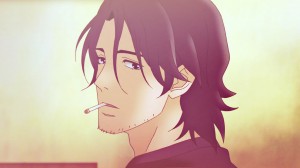
Further, take a look at his love interest, Yurika:
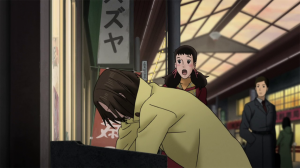
I mean, doesn’t it feel like we’ve met before?
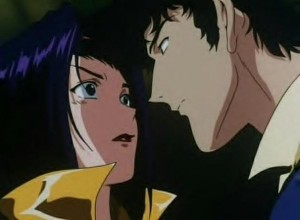
The ninth episode of Kids has a conversation very similar to Faye and Spike’s, this time at a train station. In it, Yurika, the object of both Sentarou and Junichi’s affection, tries to stop Junichi from getting on the train to Tokyo where his friend (to whom Junichi feels a profound obligation) is starting a publishing business. Like Faye, she asks him a series of questions about why he has to go, and more specifically, why he cannot take her along.
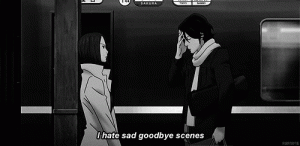
But this time, it all ends differently. In Cowboy Bebop, Spike has no idea what Faye went through in “Hard Luck Woman.” He has no idea that she is no longer on the quest to find her family or her past, and that it no longer has any control over her. He doesn’t understand what she has learned: that the past can be examined and dismissed. Similarly, Junichi has no idea that Yurika’s parents have subjected her to an unwanted gynecological examination, and that by not sleeping with her, he’s helped doom her to a brokered marriage. (This is why Yurika asks why he never “touched” her; she knows the value of her virginity to the arrangement. If she’d lost it to Junichi, there would be no brokered marriage.) Like Faye, Yurika doesn’t admit the truth, but this time, Junichi hears — in what is a very clumsy bit of exposition — that she’s late for a meeting with the broker. Stunned by this realization of what “world” Yurika will inhabit without him, he reaches out and grabs her as the train pulls away from the station. (Fellow Turner Classic Movies addicts will notice that this is almost identical to the ending of Billy Wilder’s 1957 film Love in the Afteroon.) “I’ve dragged you on board,” Junichi says. “Now what?”
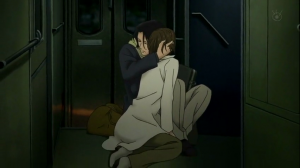
Now, I’m not saying that Watanabe is a secret Spike/Faye ‘shipper, or anything like that. What I’m saying is that he’s using Kids on the Slope to reflect on what might have been. Bebop is his original work, and the central tragedy of it is that Spike was unable to get over the past and move on toward the future. That future might never have included Faye, but it could have if Spike had the flash of insight that Junichi does. That would have changed the story entirely. With Kids on the Slope, Watanabe is using Kodama’s narrative about life’s choices to comment on his own narrative choices with his earlier works.
Similarly, Watanabe uses the ending of Kids on the Slope to discuss the ending of Samurai Champloo. In the final episode, Fuu goes alone to a remote island full of persecuted Japanese Christians to find her father, the “samurai who smells of sunflowers.” She deliberately abandons her yojimbo Jin and Mugen, knowing that not only is she endangering them if they follow her, but that the love triangle between them is too delicate and painful to be borne any longer. Naturally, they follow, and after dispatching their mutual enemies they finally face each other in single combat — just as they’ve been promising to do for the entire series.
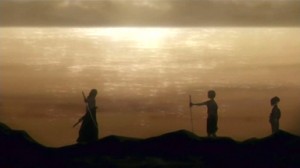
In Kids on the Slope, Senatarou flees his friends and family after involving his little sister in a terrible accident. Eight years later, Kaoru finds him on a remote island, where he’s in training to become a Catholic priest. After discovering Sen’s drum set, Kaoru summons him into the church to engage in another form of single combat: a jazz session. He plays “Moanin’,” the song that they first tried to play together (and the title of the series’ first episode), which they only mastered for the cultural festival after spending weeks apart. Now that they’ve spent years apart, they’re ready to return to each other. They play the session, then run out of the church laughing. As they run down yet another slope, they meet Ritsuko, who they haven’t seen in as many years. It’s the reunion we never saw in Samurai Champloo. The island, the church, and the hill — crucial elements in the final three episodes of that series — all return to reminds of that, much as Faye’s haircut, boots, and collar all remind us of Bebop. It’s design elements like these that evoke Watanabe’s other works while keeping each story completely independent.
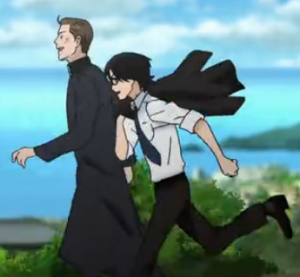
This has been a summer full of reboots, sequels, prequels, and team-ups at the American box office. Amid all that re-hashing of old material, what’s refreshing about Kids on the Slope is the way that one director can tell a fully sastisfying story that acknowledges and comments upon his earlier works while also honouring the source material. It’s a thoughtful work by a man who has clearly taken some time away to consider his craft. We’re all the richer for it.
THESE ARE A FEW OF MY FAVORITE THINGS
What a wonderful analysis! This is the first time in a long while that I’ve read a blog post about anime from beginning to end. You make a wonderful case for Spike/Faye and Jun/Yurika, comparisons I hadn’t seen while watching Kids on the Slope. I had seen the connection to Samurai Champloo’ conclusion, and I think you hit the nail on the head.
Thanks for the terrific essay!
Thanks for taking the time to comment! I’m so glad you liked the essay. Once I started, I just couldn’t stop!
Heh. That was fun.
I never thought of this at all and I love the idea of the latter work being the “what if” scenario for Spike x Faye, not that I’d actually want a different ending to Cowboy Bebop… this works.
Aww, thanks. I wouldn’t want a different ending for Bebop either, but it was really nice to see Watanabe tackle a happy ending for once. It’s nice to know that he can actually do them!
I hadn’t noticed a bunch of those connections. Great stuff!
Shared on CR.
Very good article! The only thing that could have made the end of KotS better, in my opinion, is if they would have done a montage of their lives after they finally got together along with the end credits. Something like:
– Kaoru and Ri-chan going out on a date
– Kaoru and Sen playing Jazz at an “open mic” night
– Ritsuko working as a teacher, and being teased when her Dr. boyfriend comes to pick her up at the end of the school day.
– Sen officiating Kaoru and Ritsuko’s wedding
– Sen baptizing their baby
– Sen teaching their kid to play the drums
– Pops, now a grandpa, visiting along with Jun and Yurika and their family and an impromptu jazz session breaks out with the whole gang
That kind of closure, particularly on the Kaoru/Ritsuko front, is the only thing I felt was missing for the show.
The other major critique I have of the show is the lack of character development, in particular for Kaoru. Sure, his character appears to grow as the show goes on, but in the last couple of episodes, he reverts back to the same insecure jerk he was at the beginning, only jerkier. The way he treated Ritsuko was shameful and wrong! I would have preferred to see him come out of the relationship with Sen a better person, not lame, injured, and lashing out at the one person who truly cares for both him and Sen! That reversion to his old habits was a major downer for me!
This is a wonderful article! I’d like to share this in my newsletter for the Anime club at my school. Please contact me through my email or reply to this comment. I feel as though many people don’t give Watanabe’s “Kids on the Slope” that much attention because it lacks the action scenes from his previous creations. (Also, I loved the idea of Spike and Faye together so this made me incredibly happy.) Thank you for sharing!
Sure! I’d be happy to share it with you, provided you attribute the article to me. Which anime club is it? I was the VP of mine, for a while.
Yes, of course! Thank you for replying for quickly. 🙂 It’s the Mu Epsilon Kappa Anime fraternity from the University of North Texas. Here’s the link to our page– http://unt.muepsilonkappa.com/.
i love your review!! you’ve really good at figuring out those canons of Watanabe sensei!
So that’s why during those jazz sessions I feel like it’s really a battle field in there. Thank you for the review, it’s a good wrap up after watching those three most beloved anime of Watabe sensei 😀